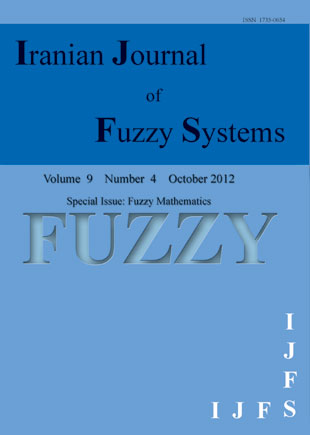فهرست مطالب

Iranian journal of fuzzy systems
Volume:9 Issue: 4, Oct 2012
- Special Issue: Fuzzy Mathematics
- تاریخ انتشار: 1391/09/01
- تعداد عناوین: 11
-
-
Pages 1-16We show that the category of convergence approach spaces is a simultaneously re ective and core ective subcategory of the category of latticevalued limit spaces. Further we study the preservation of diagonal conditions, which characterize approach spaces. It is shown that the category of preapproach spaces is a simultaneously re ective and core ective subcategory of the category of lattice-valued pretopological spaces and that the category of approach spaces is a core ective subcategory of a category of lattice-valued topological convergence spaces.Keywords: L, fuzzy convergence, L, topology, L, lter, L, limit space, Approach space, Convergence approach space, Pre, approach space
-
Pages 17-30The existing Data Envelopment Analysis models for evaluating the relative eficiency of a set of decision making units by using various inputs to produce various outputs are limited to crisp data in crisp production possibility set. In this paper, first of all the production possibility set is extended to the fuzzy production possibility set by extension principle in constant return to scale, and then the fuzzy model of Charnes, Cooper and Rhodes in input oriented is proposed so that it satisfies the initial concepts with crisp data. Finally, the fuzzy model of Charnes, Cooper and Rhodes for evaluating decision making units is illustrated by solving two numerical examples.Keywords: Data envelopment analysis, Extension principle, Fuzzy number
-
Pages 31-41In this paper a first step in classifying the fuzzy subgroups of a finite nonabelian group is made. We develop a general method to count the number of distinct fuzzy subgroups of such groups. Explicit formulas are obtained in the particular case of dihedral groups.Keywords: Fuzzy subgroups, Chains of subgroups, Maximal chains of subgroups, Dihedral groups, Recurrence relations
-
Pages 43-54The main purpose of this paper is to study the existence of a fixed point in locally convex topology generated by fuzzy n-normed spaces. We prove our main results, a fixed point theorem for a self mapping and a common fixed point theorem for a pair of weakly compatible mappings in locally convex topology generated by fuzzy n-normed spaces. Also we give some remarks in locally convex topology generated by fuzzy n-normed spaces.Keywords: Fuzzy n, normed spaces, n, seminorm, Fixed points
-
Pages 55-70The purpose of this paper is to study matrix hemiring S2 via fuzzy subsets and fuzzy h-ideals.Keywords: Г, hemiring, Fuzzy h, ideal, h, hemiregular, Matrix hemiring, Operator hemirings
-
Pages 71-97In this paper we determine the sequences of join spaces and Atanassov''s intuitionistic fuzzy sets associated with all i.p.s. hypergroups of order less than or equal to 6, focusing on the calculation of their lengths.Keywords: Fuzzy set, Atanassov's intuitionistic fuzzy set, i.p.s. hypergroup, Fuzzy grade, Join space
-
Pages 99-113This paper consider the general forms of $(\alpha,\beta)$-fuzzy left ideals (right ideals, bi-ideals, interior ideals) of an ordered semigroup, where $\alpha,\beta\in\{\in_{\gamma},q_{\delta},\in_{\gamma}\wedgeq_{\delta}, \in_{\gamma}\vee q_{\delta}\}$ and $\alpha\neq \in_{\gamma}\wedge q_{\delta}$. Special attention is paid to $(\in_{\gamma},\ivq)$-left ideals (right ideals, bi-ideals, interior ideals) and some related properties are investigated. The characterization of regular ordered semigroups in terms of $(\in_{\gamma},\ivq)$-fuzzy left (right) ideals, $(\in_{\gamma},\ivq)$-fuzzy bi-ideals and $(\in_{\gamma},\ivq)$-fuzzy interior ideals is also investigated.Keywords: Ordered semigroups, $(\alpha, \beta)$, fuzzy left (right) ideals, $(\in, {\gamma}, \ivq)$, fuzzy bi, ideals, $(\in, {\gamma}, \ivq)$, fuzzy interior ideals
-
Pages 115-132The main purpose of this paper is to introduce a concept of L- fuzzifying topological groups (here L is a completely distributive lattice) and discuss some of their basic properties and the structures. We prove that its corresponding L-fuzzifying neighborhood structure is translation invariant. A characterization of such topological groups in terms of the corresponding L- fuzzifying neighborhood structure of the unit is given. It is shown that the category of L-fuzzifying topological groups L-FYTPG is topological over the category of groups GRP with respect to the forgetful functor. As an application, the conclusion that the product of L-fuzzifying topological groups is also an L-fuzzifying topological group is proved. Finally, it is proved the forgetful functor preserves the product.Keywords: L, fuzzifying topological groups, L, fuzzifying topology, L, fuzzifying neighborhood structure, Category
-
Pages 133-140We study a fuzzy type integral for measurable multifunctions with respect to a fuzzy measure. Some classical properties and convergence theorems are presented.Keywords: Fuzzy integral, Fuzzy measure, Measurable multifunction
-
Pages 141-150In this paper, firstly, it is proved that, for a fuzzy vector space, the set of its fuzzy bases defined by Shi and Huang, is equivalent to the family of its bases defined by P. Lubczonok. Secondly, for two fuzzy vector spaces, it is proved that they are isomorphic if and only if they have the same fuzzy dimension, and if their fuzzy dimensions are equal, then their dimensions are the same, however, the converse is not true. Finally, fuzzy dimension of direct sum is considered, for a finite number of fuzzy vector spaces and it is proved that fuzzy dimension of their direct sum is equal to the sum of fuzzy dimensions of fuzzy vector spaces.Keywords: Fuzzy vector space, Fuzzy basis, Fuzzy dimension, Direct sum
-
Pages 151-158In [Fuzzy Sets and Systems 27 (1988) 385-389], M. Grabiec in- troduced a notion of completeness for fuzzy metric spaces (in the sense of Kramosil and Michalek) that successfully used to obtain a fuzzy version of Ba- nachs contraction principle. According to the classical case, one can expect that a compact fuzzy metric space be complete in Grabiecs sense. We show here that this is not the case, for which we present an example of a compact fuzzy metric space that is not complete in Grabiecs sense. On the other hand, Grabiec used a notion of compactness to obtain a fuzzy version of Edelstein s contraction principle. We present here a generalized version of Grabiecs version of the Edelstein fixed point theorem and different interesting facts on the topology of fuzzy metric spaces.Keywords: Fuzzy metric space, Cauchy sequence, G, completeness, Compactness, Fixed point theorem

